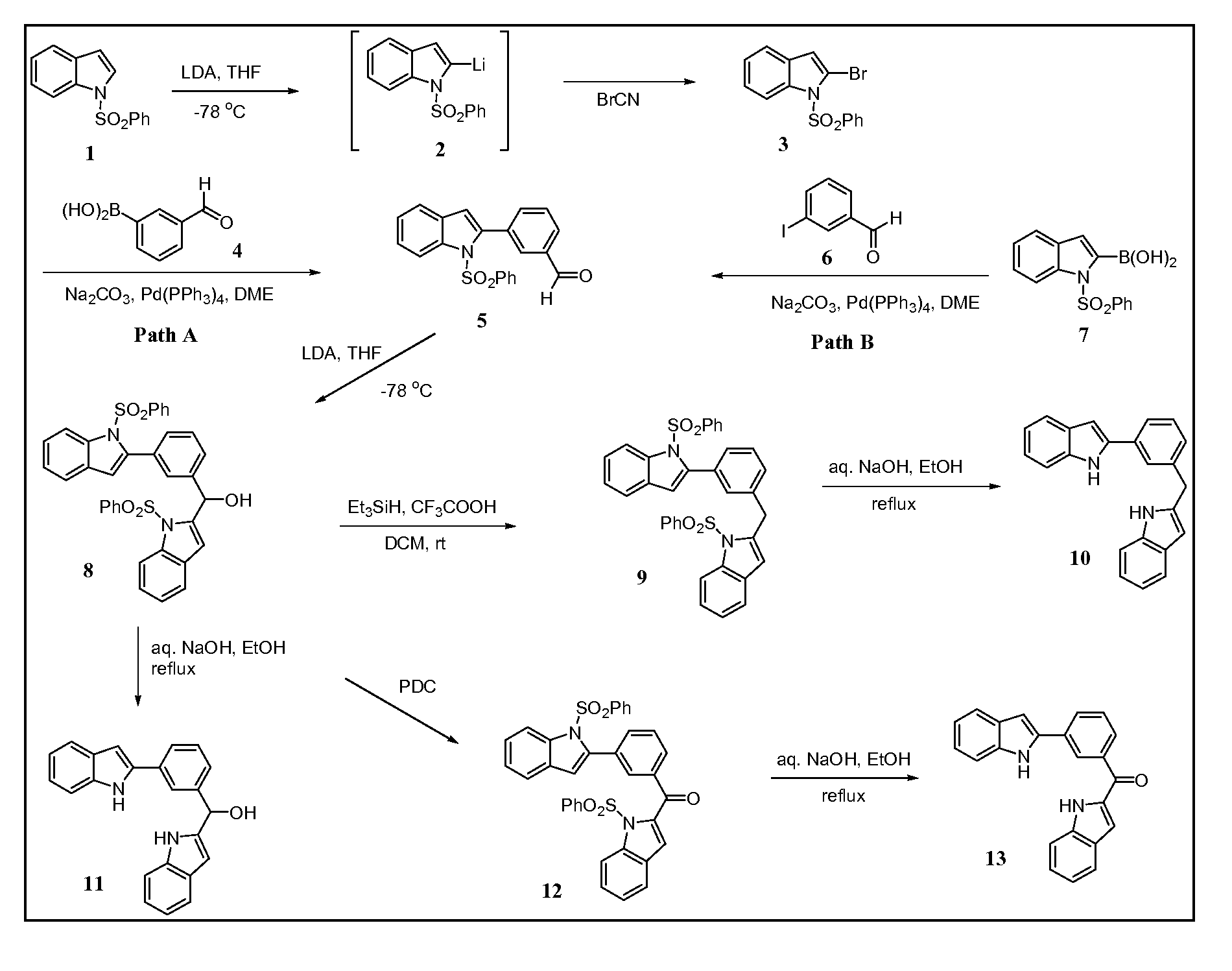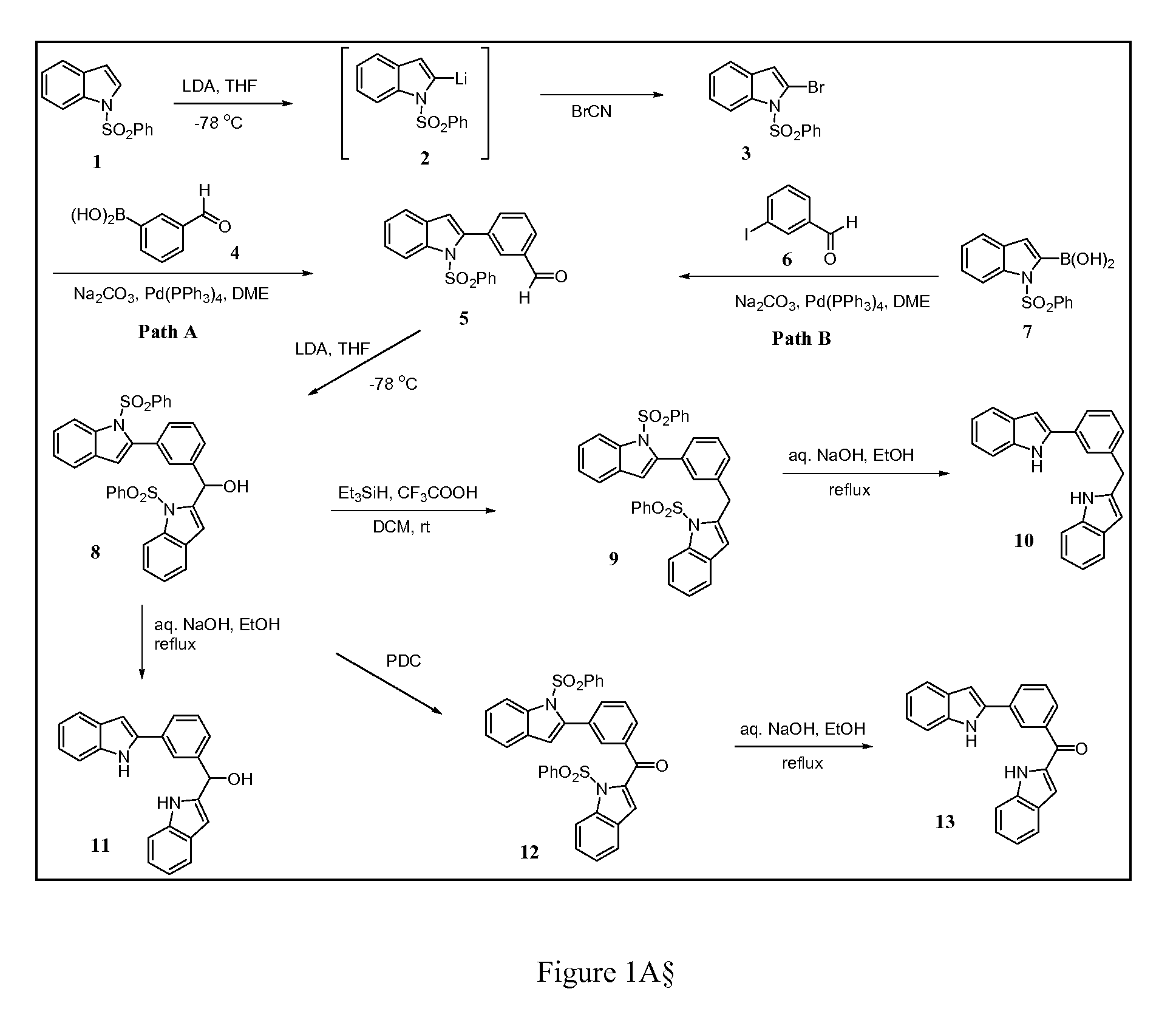Indoles, Derivatives, and Analogs Thereof and Uses Therefor
a technology of indole and derivatives, applied in the field of indole derivatives and analogs thereof and their use, can solve the problems of limiting the efficacy of indole compounds used as anticancer agents in many tumors, dosage, and loss of anticancer activity
- Summary
- Abstract
- Description
- Claims
- Application Information
AI Technical Summary
Benefits of technology
Problems solved by technology
Method used
Image
Examples
example 1
Synthesis of Compounds
[0068]General Synthetic Scheme
[0069]Known synthetic methods are used to synthesize the compounds 10, 11, and 13 as shown in FIG. 1. As shown in the synthetic scheme in FIG. 1, target diindoles 10, 11 and 13 bridged via methylphenyl linkers were prepared by removing protecting group bezenesulfonyl under reflux of ethanolic NaOH solution from corresponding precursor compounds 9, 8 and 12 using a general procedure described below. Intermediate compound 8 is key to the subsequent synthesis of compounds 10, 11 and 13. Compound 8 is synthesized from the coupling of protected indole 1 with protected indole benzaldehyde compound 5 in the presence of lithium diisopropyl amide (LDA) as a 94% yield. Compound 5 may be synthesized using two different Suzuki coupling pathways, path A and path B.
[0070]For path A, the lithiation of protected indole 1 by LDA to yield indole 2 followed by bromination with cyanogen bromide (BrCN) produced bromoindole 3. The synthesized bromoindol...
example 2
Additional Synthetic Schemes for General Compound Analogs
[0138]Compound Analogs 14-20
[0139]Structural analogs of diindole 13 are shown in FIG. 1B. The structural analog compounds 14-20 are synthesized according to the general synthetic plan outlined in Schemes 2 through 4 (76-78) shown in FIGS. 1C-1E. For analog compound 14, a variety of substituted indole rings are prepared as shown in Scheme 2. To accomplish this, a variety of N-protected indoles 33 are synthesized from commercially available reagents and brominated at the 2-indole position to produce their corresponding bromides, 34. The bromides in turn are coupled via Suzuki reaction with aldehydoboric acid 4 to yield the corresponding aldehydo-indoles 35, key intermediates in this approach.
[0140]This class of aldehydo-indoles 5A, as shown in Scheme 3, are reacted with the 2-N-protected indole 1 under basic conditions to promote regioselective deprotonation and produce the hydroxymethylene compounds 8A in high yield. Correspond...
example 3
[0150]In vitro and in vivo Methods
[0151]Cell viability (LNCaP, PC-3 prostate, DU145, PPC-1, and TSU-Pr1 prostate cancer cell lines, HT-29 colon cancer cell line, and MCF-7 breast cancer cell line) was quantitated using the sulforhodamine B (SRB) assay after 96 h coincubation with different concentrations of compound in 96-well plates. Cell viability of leukemia cells (K562 and doxorubicin-resistant K562 / Dox) was quantitated by MTT assay after 96 h coincubation with different concentrations of compound in 96-well plates. Drug-induced apoptosis was determined by anti-histone ELISA assay and DNA laddering. Cell cycle progression was assessed by propidium iodide staining and fluorescence-activated cell sorting (FACS) analysis. In vitro tubulin polymerization assay was determined by CytoDYNAMIX ScreenTM3 (CDS-03) kits according to the manufacturer's instructions. Anti-apoptosis protein (Bcl-2 and Bcl-xl) and pro-apoptosis protein (Bax) were examined in LNCaP and PC-3 after 24 h incubatio...
PUM
 Login to View More
Login to View More Abstract
Description
Claims
Application Information
 Login to View More
Login to View More - R&D
- Intellectual Property
- Life Sciences
- Materials
- Tech Scout
- Unparalleled Data Quality
- Higher Quality Content
- 60% Fewer Hallucinations
Browse by: Latest US Patents, China's latest patents, Technical Efficacy Thesaurus, Application Domain, Technology Topic, Popular Technical Reports.
© 2025 PatSnap. All rights reserved.Legal|Privacy policy|Modern Slavery Act Transparency Statement|Sitemap|About US| Contact US: help@patsnap.com



